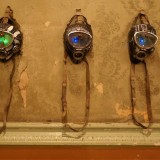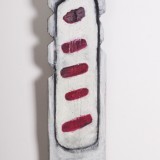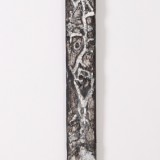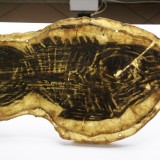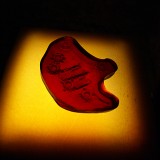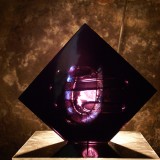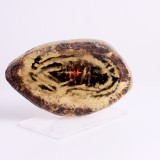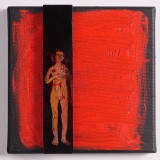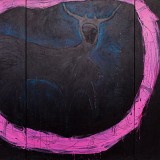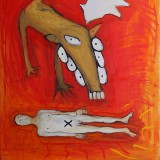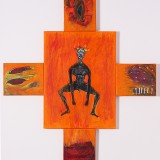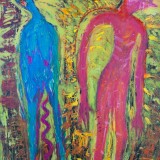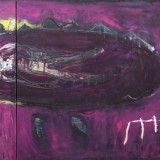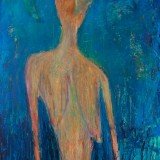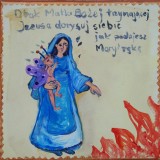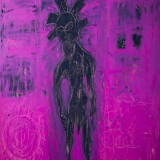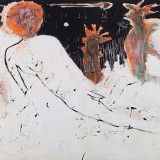Piotr Ambroziak
Piotr Ambroziak (born 1971) studied at the Department of Graphics and Painting within the Academy of Fine Arts in Łódź. In 1996 he defended his diploma with honours at the Studio of Wood Engraving run by Professor Andrzej Bartczak (plus an annex of additional studies in photography supervised by Prof. Ireneusz Pierzgalski). He was also a student of Prof. Juliusz Narzyński in the Studio of Painting. Mostly he creates paintings and objects, but he also devises artworks in other art disciplines, often blurring the borders between them. He is a participant of many artistic associations (Kultura Aktywna, Młodzi Sztuką, Otwarta Wystawa). In 1995 he received a bursary from the Polish Ministry of Culture and Art. The expressive paintings which he creates belong to figurative trend. The figure presented is the conveyer of meanings and gives the painting its context. It is often simplified, deformed or treated as an ambiguous sketch. Ambroziak refers most often to archetypical images: of good and evil, a woman and man, a devil, angel, a saint. He reaches various mythologies and beliefs, recalling not only the images of goddesses, gods and demons, but also biblical figures, including Christ. The reference to mythological and religious sources are taken out of their traditional ‘cult’ context by the artist and often in a very bold way placed in the contemporary reality. Through such a measure the figures and scenes take up a new meaning and the artist stretches a platform between tradition and contemporary times, in which rooted cultural patters are often questioned.
An integral part of some paintings are manually made texts, which allows us to read new contexts out of the traditional images. The connection of an image and a text reveals a more specific content and also finds connections with the contemporary world. Thanks to the text which on the one hand explains the content of the paintings and on the other is often a witty comment by the artist upon reality observed, Ambroziak’s works are an answer to a surrounding reality, which the artist strips out of metaphor and illusion. Ambroziak’s paintings are universal, but the artist refers to his own experiences to situations he presents. He is a careful and courageous observer and in his statements one can see a sensitivity towards important, although sometimes uncomfortable topics.
Quite important in Ambroziak’s art is his casual juggling with the patterns rooted in culture, reaching the sub-consciousness, imagination, dreams. The world presented by the artist is grounded somewhere on the border of reality and fantasy, reality and dream, experiences and desires, sacrum and profanum, universal and individual message.
Ambroziak also creates objects. Some of them resemble totems, others – much smaller – evoke associations with magic items associated Earth worshipping. Petty forms made of semi-transparent materials are often back-lit and the light whose source is not visible for the viewer is situated underneath. In this way the artist achieves an effect of the emanation of light, referring to the role which it fulfilled in the middle ages especially in religion but also in art. Through reference to the cultural and religious meaning of light, Ambroziak gives an illusion to art which fulfils a role in religious cult or magic. The energy which one feels when looking at his artworks does not allow the viewer to forget that we are dealing with art and not with the objects of cult – in spite of their great force. Therefore the entire power of artworks, if we assume that they have it, comes from the artist. The artworks created by Ambroziak allow the visualisation of primary forces. They become a kind of a frame, marking the borders in which they can be expressed. Piotr Ambroziak very scrupulously and successfully fills the opportunities which art gives him.
Sharp forms, bold contrasts of colours, a decided gesture and the deformation with which the artist operates in painting, are excellent measures to present the energy of life. Similarly as with the small objects of organic shapes and natural, neutral colours, which direct the attention of the viewer to the hidden powers of nature. In both cases Ambroziak is able to express the energy, but, what’s important and valuable, he avoids allegory and personification. In his works he often contrasts opposite powers: the active and passive elements, masculine with feminine, hot with cold, pagan with Christian, primary with contemporary, but contrasting the values in his works looses the element of opposition and becomes complementary.
In Ambroziak’s art there appear references to various cultures, religions, and historical figures, but always the images are filtered through contemporary times and provided with a current comment. In his “search for the sources of power” the artist does not hesitate to reach for the sub-consciousness and even to reveal its dark side. This way the artist uses his own metaphors, with which he describes the contemporary world.
Karolina Jabłońska


